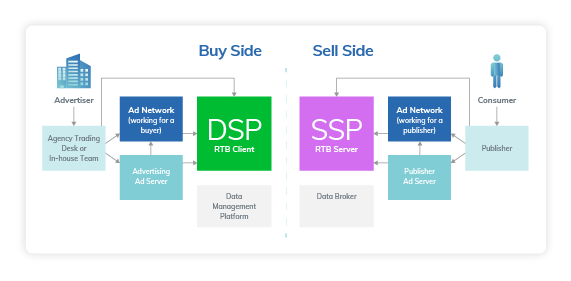Understanding the differences between a demand side platform and a supply side platform is essential if you want to incorporate the advantages of programmatic DOOH (pDOOH) into your marketing strategy.
Digital out of home (DOOH) advertising is growing rapidly in popularity as a marketing tool. Recent estimates expect that the global DOOH market will have doubled its 2020 value by 2027 – serious growth indeed, especially in a decade that has so far been mired by significant economic slowdowns.
Growth is being driven in no small part by new ways of buying ad space on digital signage. Programmatic DOOH automates the bidding process based on parameters set by buyers.
This removes expensive and time-consuming third parties from the media buying process and opens up the possibility of audience targeting with advanced data analytics, across all venue types.
Programmatic DOOH is bought and sold via platforms that link buyers directly with premium DOOH inventory around the globe. Demand side platforms (DSPs) and supply side platforms (SSPs) are two separate ad tech tools that lie at opposite ends of the same process. In a nutshell, SSPs help inventory owners sell ad space and DSPs help advertisers buy it.
The two may be linked by a separate ad exchange or integrated directly together to avoid the use of third-party ad exchangers.

(Image source: digitaladblog.com)
Below, we take a look at how DSP and SSP platforms work for buyers and sellers and what each should look for when finding an ad platform that works for them.
What Is a Demand Side Platform (DSP)?
Unlike supply side platforms, demand side platforms are buyer-facing. This means they are designed for use by businesses who want to buy space on digital signage and ad networks from world-renowned inventory owners like JCDecaux, Clear Channel and Global Outdoor.
Demand side platforms automate the process for bidding on DOOH ad inventory, thus cutting the time and cost associated with traditional media buying agencies. This opens up OOH digital advertising to smaller businesses who previously haven’t been able to shoulder the costs and time commitments of traditional DOOH buying processes.
Demand side platforms for DOOH work in a similar manner to those used in online advertising. Buyers define their budget and the conditions under which they would like to buy ad space and the platform does the rest.
What Should Demand Side Platforms Offer Their Users?
One of the reasons why programmatic advertising is so appealing to a wide range of businesses is the targeting capabilities it offers. With pDOOH, you can choose the conditions under which your digital ads are shown, and only pay for ad space when these conditions are met. A DSP should allow you to bid for inventory based on, among others things:
- Time of day, week, or month
- Estimated footfall
- Temperature and other external conditions
Another major advantage of programmatic DOOH is that it enables the use of real-time analytics to track the success of an ad campaign in real time and thereby facilitate on-the-fly optimization. Look for DSPs with plenty of reporting features – you should be able to track the following:
- Budgets by campaign, publisher and creative
- Number of ad impressions by campaign, screen, location, creative etc.
- Individual screen delivery and performance, including number of playouts
- Cost per thousand ad impressions (effective cost per mile, or eCPM)
What is a Supply Side Platform (SSP)?
In contrast to media buyer-facing demand side platforms, supply side platforms are used by DOOH publishers to sell space on their ad network directly to buyers. SSPs help ad sellers optimize revenue from their inventory via effective distribution.
Supply side platforms remove the need for OOH publishers/Media owners to engage media buying agencies to connect them with potential customers. For advertising companies, SSPs present a huge opportunity to cut down on the cost of intermediaries in the selling process and maximize revenues.
This is because supply side platforms automate the ‘selling’ side of the programmatic advertising bidding process based on buyers’ needs and sellers’ targeting capabilities.
Much like their counterparts in online advertising, SSPs remove the need for extensive conversations with buyers about where, when and how their ad campaign should be displayed. Instead, it all boils down to hard data. If publishers have inventory available that matches a buyer’s preferences, SSPs help both parties find each other.
What Should Supply Side Platforms Offer Their Users?
Supply side platforms should be easy to navigate and intuitive to use to maximize the efficiency gains they offer inventory owners. In terms of features, they should offer:
- Custom reporting: publishers need to know how their digital signage is performing in real time to optimize performance
- Yield optimization: automated inventory allocation and reallocation to increase ad impressions, reduce unused inventory and optimize screen performance
- Ad exchange mechanisms or pre-built integrations with DSPs: these allow you to connect your SSP directly with a DSP without going through a third-party ad exchange
Inventory and campaign management features: these give suppliers control over inventory management and campaign distribution
Finding the Right Demand Side Platform for You
If you want to include programmatic DOOH successfully in your marketing strategy, the right demand side platform is a must. A powerful DSP will allow you to save time through automated bidding, enable you to target audiences on a mass scale and track campaign success in real time.
The Neuron is integrated with some of the leading SSPs worldwide. We provide unparalleled access to top inventory owners enabling our clients to achieve both a local and global footprint.
With an intuitive interface, in-depth analytics and in-built automation, The Neuron saves you time whilst helping you target the audiences that matter to your business.
You can upload creative, bid on inventory and set your campaign live in just a couple of clicks – the platform does the rest.


